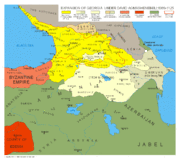Kipchaks in Georgia
2007 Schools Wikipedia Selection. Related subjects: Peoples
Kipchaks are an ancient nomadic Turkic people who occupied large territories from Central Asia to Eastern Europe. They played an important role in the history of many nations of living in the region, Georgia among them. At the height of this Caucasian power from the 12th to the 13th centuries, Georgian monarchs recruited thousands of the Kipchak mercenaries and successfully exploited their service against the neighboring Muslim states.
History
Early period
The first contacts between the Georgians and Kipchaks date back to the eleventh century when the latter founded a nomadic confederation in the southern Russian steppes. Their relations with Georgia seem to have been generally peaceful. Moreover, the Georgian politicians of that time saw the Kipchaks as their potential allies against the Seljuk conquests. According to Georgian chronicles, Georgians knew about the "Kipchaks' good fighting skills, their bravery, and the enormous human resources that they had."
The architect of the Georgian-Kipchak alliance was the Georgian king David IV “the Builder” ( 1189- 1125), who employed tens (or even hundreds) of thousands Kipchak soldiers and settled them, in 1118, in his kingdom. This measure, one of the central parts of David’s military reforms amid his struggle against the Seljuk invaders, had been preceded by the visit of the high-ranking Georgian delegation, including the king himself and his chief adviser and tutor George of Chkondidi, to the Kipchak headquarters. To secure the alliance with these nomads, David married a Kipchak princess Gurandukht, daughter of Khan Otrak (Atraka, son of Sharaghan, of the Georgian chronicles), and invited his new in-laws to settle in Georgia. David mediated a peace between the Kipchaks and Alans, and probably had some consultations also with the Velikiy Kniaz of Kievan Rus', Vladimir Monomakh, to secure a free passage for the Kipchak tribesmen to the Georgian soil.
As a result of this diplomacy, 40,000 Kipchak families under Otrak moved to settle in Georgia. According to the agreement, each Kipchak family was to contribute a full-armed soldier to the Georgian army. They were given land, rearmed and became a perfect regular force under the immediate control of the king. The selected 5,000 men were enrolled in the royal guards. The remaining Kipchak settlers were posted chiefly to frontier regions confronting the Seljuk Turks. They practiced a semi-nomadic way of life, wintering in the Kartlian lowlands in central Georgia, and carrying their summertime duties along the foothills of the Caucasus.
The medieval compendium of the East Slavic chronicles known as Hypatian Codex relates that after the death of Vladimir Monomakh in 1125, Khan Syrchan of the Don Kipchaks, Otrak’s brother, sent a singer Or’ to Otrak and asked him to return home. Legend has it that when Otrak heard Or’ singing an old Kipchak song and smelled steppe grass, he fell in nostalgia with the steppe life and finally left Georgia. Yet a number of the Kipchak mercenaries settled permanently within Georgia, converted to Orthodox Christianity, and blended subsequently with the local population.
Later period
The Christianized (and already Georgianized) Kipchak officers, known to the Georgians as naqivchaqari (i.e., "de-Kipchakized"), played a crucial role in suppressing the noble revolts of that time. Through their loyal service to the Georgian crown, they grew in influence and prestige, and emerged during the reign of George III ( 1156- 1184) as a new military aristocracy in sharp contrast to old and frequently self-minded Georgian feudal lords. Not surprisingly, this caused a great discontent in the aristocratic opposition which would force George’s successor Queen Thamar (1184- 1213) to retire virtually all high-ranking assimilated Kipchaks, particularly Qubasar, Afridon and Qutlu Arslan. The latter is sometimes referred to as the Georgian Simon de Montfort for his demand to limit the royal power.
Yet Thamar and her successor, George IV Lasha (1213- 1223), continued to employ new Kipchak mercenaries, perhaps in tens of thousands. They were referred by the Georgians as qivchaqni akhalni, i.e., "new Kipchaks". One part of them, however, was refused to be enrolled in the royal army, and they moved on to Ganja, Arran, in what is now Azerbaijan. The Georgians subsequently defeated these marauding bands and scattered them. Although the Kipchaks continued to serve in the Georgian ranks, a number of the Kipchak units joined the Khwarezmian prince Jalal ad-Din Mingburnu in his expedition against Georgia in 1225, guarantying thereby his victory. The Kipchaks remained on both sides of the divide during the Mongol campaigns in Georgia in the late 1230s, but most of them subsequently intermingled with the Mongol hordes.
Legacy
According to modern Turkish scholars, the traces of the Kipchak presence in Georgia can be found in the Turkish-Georgian borderlands, particularly in the Rize Province. They relate some of the existing local family names to the Kipchak clans who had once served to Georgia. The Kumbasars, the purported descendants of the above mentioned Qubasar (Kubasar), are an example. The Meskhetian Turks, a large Muslim community deported from Georgia under the Soviet dictator Joseph Stalin in 1944, also claim sometimes that the medieval Kipchaks of Georgia may have been one of their possible ancestors


